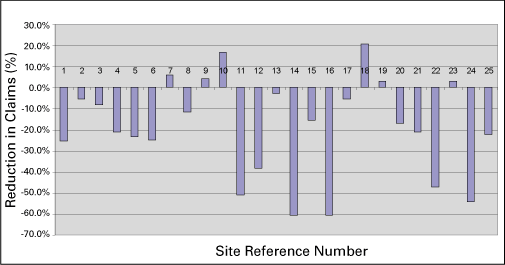 |
By utilizing the methodology described in the preceding section, the treatment effects can be calculated for each improvement site. Table 3 below shows the results for the reductions in the total claims for the 25 sites.
Table 3: Reductions Factors for each Improvement Site
| ID No. | Site Type | Major Road | Minor Road | City Location | Claims Reduction1. |
|---|---|---|---|---|---|
1 |
Treatment |
Rte
17 |
Halibuton |
Saanich |
-25.5% |
2 |
Treatment |
Rte
17 |
Island
View |
Saanich |
-5.5% |
3 |
Treatment |
Rte
17 |
Beacon |
Saanich |
-8.2% |
4 |
Treatment |
Rte
1 |
Morden |
Nanaimo |
-21.0% |
5 |
Treatment |
Rte
1 |
Cedar
Rd N. |
Nanaimo |
-23.4% |
6 |
Treatment |
Rte
19 |
College
Rd |
Nanaimo |
-24.9% |
7 |
Treatment |
Rte
19 |
Jingle
Pt |
Nanaimo |
6.1% |
8 |
Treatment |
Rte
19 |
Northfield |
Nanaimo |
-11.7% |
9 |
Treatment |
Rte
19 |
Molstar/Jingle |
Nanaimo |
4.3% |
10 |
Treatment |
Rte
19 |
Aulds |
Nanaimo |
16.8% |
11 |
Treatment |
Rte
19 |
Ware |
Nanaimo |
-51.0% |
12 |
Treatment |
Rte
19 |
Cook
Creek |
Qualicum |
-38.3% |
13 |
Treatment |
Rte
19 |
Cliff |
Courtney |
-2.8% |
14 |
Treatment |
Rte
19 |
Comox |
Courtney |
-60.7% |
15 |
Treatment |
Rte
19 |
Ryan |
Courtney |
-15.4% |
16 |
Treatment |
Rte
19 |
26th
St |
Courtney |
-60.7% |
17 |
Treatment |
Rte
97 |
Rt
33 |
Kelowna |
-5.5% |
18 |
Treatment |
Rte
97 |
Prairie
Valley |
Summerland |
20.6% |
19 |
Treatment |
Rte
97 |
Rosedale |
Summerland |
2.9% |
20 |
Treatment |
Rte
97 |
Banks |
Kelowna |
-16.9% |
21 |
Treatment |
Rte
97A |
Smith |
Armstrong |
-21.0% |
22 |
Treatment |
Rte
97A |
Cliffe |
Enderby |
-47.2% |
23 |
Treatment |
Rte
16 |
1st
Ave |
Prince
George |
3.0% |
24 |
Treatment |
Rte
17 |
17th
Ave |
Prince
George |
-54.0% |
25 |
Treatment |
Rte
18 |
20th
Ave |
Prince
George |
-22.3% |
Total
Overall |
-14.8% |
||||
1.A negative value indicates a reduction
Of the 25 sites that were and investigated in this study, a total of 19 sites have shown a reduction in the number of claims after the implementation of the improvements to the conspicuity of the signal head backboard. The magnitude of the reduction in claim frequency ranged from a low of 2.8 percent to a high of 60.7 percent. Overall, it is estimated that the improvements to the signal head backboard will result in a 14.8 percent reduction in the total number of claims at an improved intersection. A total of 6 of the 25 improvement sites experienced an increase in the number of claims after the improvements to the signal head, with the magnitude of the increase ranging from a low of 2.9 percent to a high of 20.6 percent. These results are shown graphically below in Figure 4.
Figure 4. Reduction in the Total Claims at Treatment (Improved) Sites

As mentioned earlier, this current phase of the study represents the follow-up from an original study (phase 1) undertaken by Sayed in 1998 (Sayed et. al, 1998(1)). A similar methodology was used in the original study, with the exception that a reference group was used to account for the regression to the mean bias instead of the prediction model that was used in this study. In addition, the original study utilized collision data and not claims data. Based on 10 treatment sites in phase 1 of the study, Sayed reported a reduction of 24 percent in the total number of accidents. This result is considered to be consistent with the results of this study (i.e., 15 percent reduction), given the noted differences between the two studies.
There are several opportunities to expand the safety analysis, which will be completed and published at a later date. These opportunities include increasing the number of treatment sites, disaggregating the safety performance analysis into high severity claims (fatal and injury) and low severity claims (property damage only), determining the economic justification (i.e., benefit-cost ratios) for the signal head backboard upgrade, and evaluating the reliability of the results (Sayed and de Leur, 2001).
|
United States Department of Transportation - Federal Highway Administration |
||